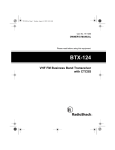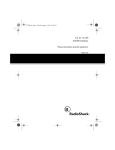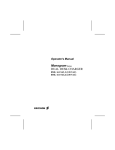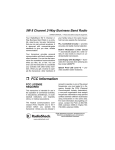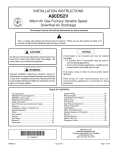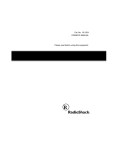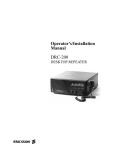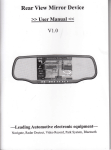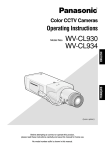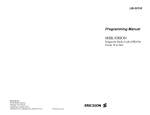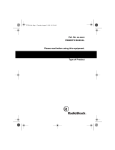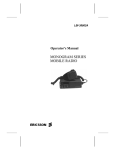Download Ericsson NPC-50 Operator`s manual
Transcript
Operator’s Manual Portable Radio Unit NPC-50 ericssonz NOTICE! This manual covers Ericsson and General Electric products manufactured and sold by Ericsson Inc. NOTE! Repairs to this equipment should be made only by an authorized service technician or facility designated by the supplier. Any repairs, alterations or substitution of recommended parts made by the user to this equipment not approved by the manufacturer could void the user’s authority to operate the equipment in addition to the manufacturer’s warranty. NOTE The software contained in this device is copyrighted. Unpublished rights are reserved under the copyright laws of the United States. This manual is published by Ericsson Inc., without any warranty. Improvements and changes to this manual necessitated by typographical errors, inaccuraciees of current information, or improvements to programs and/or equipment, may be made by Ericsson Inc., at any time and without notice. Such changes will be incorporated into new editions of this manual. No part of this manual may be reproduced or transmitted in any form or by any means, electronic or mechanical, including photocopying and recording, for any purpose, without the expressed written permission of Ericsson Inc. Copyright © January 1996, Ericsson Inc. 2 TABLE OF CONTENTS GUIDELINES FOR SAFE AND EFFICIENT USAGE OF YOUR RADIO . . . . . . . . . . . . . . . . . . . . . 4 OPERATING RULES AND REGULATIONS . 4 INTRODUCTION . . . . . . . . . . . . . . . . 5 AVAILABLE CHANNEL FREQUENCIES . . 5 UNPACKING YOUR RADIO . . . . . . . . . . 5 CONTROLS AND FUNCTIONS . . . . . . . . 6 FCC LICENSING . . . . . . . . . . . . . . . . 7 GETTING STARTED . . . . . . . . . . . . . GETTING YOUR RADIO READY TO USE Setting The RF Frequency . . . . . Opening The Battery Compartment . Attaching The Belt Clip . . . . . . . Mounting The Antenna . . . . . . . Installing Battery Pack . . . . . . . . . 7 . 7 . 8 . 8 12 12 13 USING THE RADIO . . . . . . . . . . . . . 14 CHARGING THE BATTERY . . . . . . . . 14 TRANSMITTING AND RECEIVING . . . . 14 BATTERY INFORMATION . . . . . . . CHARGE BEFORE USING . . . . . RECHARGING THE BATTERY . . . Battery Low Indication . . . . . BATTERY CARE & MAINTENANCE BATTERY RECYCLING . . . . . . . . . . . . . . . . . . . . . . . . . 15 15 16 16 16 16 OPERATING TIPS . . . . . . . . . . . . . EFFICIENT RADIO OPERATION . . . . ANTENNA CARE AND REPLACEMENT ELECTRONIC DEVICES . . . . . . . . AIRCRAFT . . . . . . . . . . . . . . . . BLASTING AREAS . . . . . . . . . . . POTENTIALLY EXPLOSIVE ATMOSPHERES . . . . . . . . . . . . . . . . . . 17 17 17 17 18 18 . 18 FCC RULES PART 90 . . . . . . . . . . . . 18 ACCESSORIES . . . . . . . . . . . . . . . 20 OPTIONAL ACCESSORIES . . . . . . . . 20 REPLACEMENT PARTS . . . . . . . . . 20 NPS-50 PORTABLE RADIO LIMITED WARRANTY . . . . . . . . . . . . 21 NPC-50 PORTABLE RADIO LIMITED WARRANTY . . . . . . . . . . . . 22 3 GUIDELINES FOR SAFE AND EFFICIENT USAGE OF YOUR RADIO Important: Read this Information Before Using Your Portable Radio OPERATING RULES AND REGULATIONS Two-way FM radio systems must be operated in accordance with the rules and regulations of the Federal Communications Commission (FCC). As an operator of two-way radio equipment, you must be thoroughly familiar with the rules that apply to your particular type of radio operation. Following these rules will help eliminate confusion, assure the most efficient use of the existing radio channels and result in a smoothly functioning radio network. The following offenses are punishable by fine, imprisonment, or both. When using your two-way radio, remember these rules: 1. It is a violation of FCC rules to interrupt any distress or emergency message. As your radio operates in much the same way as a telephone "party line", always listen to make sure that the channel is clear before transmitting. Emergency calls have priority over all other messages. If someone is sending an emergency message - such as reporting a fire or asking for help in an accident - KEEP OFF THE AIR! 2. The use of profane or obscene language is prohibited by Federal Law. 3. It is against the law to send false call letters or false distress or emergency messages. 4. It is against Federal Law to repeat or otherwise make known anything you overhear on your radio. Conversations between others sharing your channel must be regarded as confidential. 5. No changes or adjustments shall be made to the equipment except by an authorized or certified electronic technician. 4 INTRODUCTION The portable radio you have purchased will provide you with reliable two-way communications when properly used. It is important that you read and understand this manual to obtain the best possible performance and long time operation of your radio. This radio is available in two different versions. One version operates in the VHF band (151-159 MHz) on one of sixteen (16) user selectable frequencies. The other version operates in the UHF band (462-470 MHz) on one of sixteen (16) user selectable frequencies. In addition, each version can be set up with one of thirty-eight (38) user selectable CTCSS tones. These CTCSS tones help block the reception of other radio messages that may be on the same RF frequency as your particular radio. The user may also disable this feature. AVAILABLE CHANNEL FREQUENCIES Each radio operates on one of 16 pre-set frequencies. Refer to Table 1 (VHF) or 2 (UHF) for a listing of available frequencies. Information is also indicated on frequencies requiring no license or channels in the General Mobile Radio System (GMRS) that may be used for personal use only under FCC Part 95 Rules. UNPACKING YOUR RADIO Remove all the items from the packing box and identify each item. Check off the items as you remove them from the box. Operator’s Manual AE/LZT 123 1896 Safety Instructions AE/LZY 123 1897 VHF Portable Radio KRD 103 127/1 UHF Portable Radio KRD 103 127/2 Antenna, VHF KRE 101 1503/1 Antenna, UHF KRE 101 1503/2 Battery BKB 191 208/1 Wall Cube Charger BML 161 63/1 If any of these items are missing from the box,contact your dealer for help. 5 CONTROLS AND FUNCTIONS 1. 2. 3. 4. 5. 6. 7. 8. 9. 10. 11. 12. Antenna Built-In Microphone On/Off Switch/Volume Control Built-In Speaker Antenna Connector Transmit LED Rubberized Jack Cover External Speaker Jack External Microphone Jack Charge Jack Push-To-Talk (PTT) Switch Monitor Switch 6 FCC LICENSING Before using your radio, you must have a station license issued by the Federal Communications Commission (FCC). It is illegal to transmit without the appropriate license. You must submit FCC Form 600 and any appropriate attachments to PCIA (Personal Communications Industry Association), which is the organization responsible for coordinating conflicts. For more information about PCIA, call (800) 759-0300 ([n Virginia call (703) 739-0300]. To get current FCC forms and instructions, you can: • Have the forms mailed to you by calling the FCC forms Hotline at (800) 418-FORM. • Have the forms faxed to you by the FCC’s Fax-On-Demand system at (202) 418-0177. Request Document 000600 for all forms and instructions, Document 006001 for instructions only, Document 006002 for Form 600 Main Form only, or Document 006003 for all schedules. For questions about the license application, call the FCC at (717) 337-1212. You are also required to have in your possession, a current copy of Part 90 of the FCC Rules and Regulations before operating your radio. It is also your responsiblity to insure your radio operates in accordance with the guidelines established by the FCC. See the section FCC Rules Part 90 in the back of this manual for additional information on the operation of your radio. GETTING STARTED GETTING YOUR RADIO READY TO USE Several operations must be performed before using your radio: • Selecting the operating frequency of the radio • Selecting or disabling the CTCSS tone • Attaching the belt clip • Mounting the antenna • Checking battery installation and charging the battery 7 Setting The RF Frequency Refer to Table 1 (VHF) or Table 2 (UHF) for the DIP switch setting for the desired operating RF frequency of the radio. The DIP switch bank is located in the upper right hand corner of the battery compartment. Use a pencil point or small object to position the DIP switches to the corresponding setting. NOTE Each radio has been pre-programmed to operate on 151.6250 (VHF) or 464.5000 (UHF) MHz. Opening The Battery Compartment CAUTION The battery pack is protected with a plastic wrap. Do not remove this because damage to the battery may result. 1. Unlock the battery compartment by pushing on the latches on either side. 2. Remove the cover by sliding it down and away from the radio. 8 ON S1 S2 S3 S4 For example: To change the pre-programmed RF frequency of 151.6250 to 158.4000, set S1 to ON, S2 to OFF, S3 and S4 to ON position. Table 1 - VHF RF Frequency Settings SWITCH POSITION FREQ. (MHz) 151.6250 151.6550 151.6850 151.7150 151.7750 151.8050 151.8350 151.8950 151.9250 151.9550 154.4900 154.5150 154.5400 154.5700 154.6000 158.4000 * S1 ON OFF ON OFF OFF ON ON OFF ON OFF OFF ON OFF OFF ON ON S2 ON ON OFF ON ON OFF ON OFF ON OFF ON OFF OFF OFF ON OFF S3 OFF ON ON OFF ON OFF OFF ON ON ON OFF OFF OFF OFF ON ON S4 OFF ON OFF ON OFF ON ON OFF OFF ON OFF OFF ON OFF ON ON ON = switch set towards speaker OFF = switch set towards battery * Itinerant frequency, no license required 9 Table 2 - UHF RF Frequency Settings SWITCH POSITION FREQ. (MHz) 462.5750 ** 462.6250 ** 462.6750 ** 464.3250 464.5000 464.5500 * 464.8250 467.7625 ** 467.8125 467.8500 467.8750 467.9000 467.9250 469.2625 469.5000 * 469.5500 * S1 OFF OFF ON ON OFF ON OFF ON OFF ON OFF ON OFF ON OFF ON S2 ON ON OFF ON OFF ON OFF ON OFF ON OFF OFF ON OFF ON OFF S3 OFF ON OFF OFF ON OFF ON ON OFF ON OFF OFF ON ON OFF ON S4 ON OFF ON ON ON OFF OFF ON OFF OFF ON OFF ON OFF OFF ON ON = Switch set towards speaker OFF = switch set towards battery * Itinerant frequency, no license required ** GMRS frequency, personal use only Setting CTCSS Tones Refer to Table 3 for DIP switch settings for the CTCSS tones. The DIP switches are located in the upper left hand corner of the battery compartment. Use a pencil point or other small object to set the DIP switches to the corresponding position. NOTE The radio has been pre-programmed for a CTCSS tone of 156.7 Hz. ON 1 2 3 4 56 7 8 For example: To change the pre-programmed CTCSS tone of 156.7 to 100.0, set the following switches. Set S1 to OFF, S2 to ON, S3 and S4 to OFF, S5 to ON and leave all other switches to the ON position. 10 To disable the CTCSS tone feature, set S8 to the OFF position. All other switches can be left in their existing positions. Table 3 - CTCSS Tone Settings SWITCH POSITION FREQ. (Hz) 67.0 71.9 74.4 77.0 79.7 82.5 85.4 88.5 91.5 94.8 97.4 100.0 103.5 107.2 110.9 114.8 118.8 123.0 127.3 131.8 136.5 141.3 146.2 151.4 156.7 162.2 167.9 173.8 179.9 186.2 192.8 203.5 210.7 218.1 225.7 233.6 241.8 250.3 Disabled S1 S2 S3 S4 S5 S6 S7 S8 OFF OFF ON OFF OFF ON ON ON OFF OFF ON OFF ON ON OFF OFF ON ON OFF OFF ON ON OFF OFF ON ON OFF OFF ON ON OFF OFF ON ON OFF OFF ON ON X OFF OFF OFF OFF ON OFF ON OFF OFF ON OFF ON ON ON OFF OFF OFF OFF ON ON ON ON OFF OFF OFF OFF ON ON ON ON OFF OFF OFF OFF ON ON ON ON X OFF OFF OFF OFF OFF OFF OFF OFF ON OFF ON OFF OFF OFF ON ON ON ON ON ON ON ON OFF OFF OFF OFF OFF OFF OFF OFF ON ON ON ON ON ON ON ON X OFF OFF OFF OFF OFF OFF OFF OFF OFF OFF OFF OFF OFF OFF OFF OFF OFF OFF OFF OFF OFF OFF ON ON ON ON ON ON ON ON ON ON ON ON ON ON ON ON X OFF OFF OFF ON OFF OFF OFF ON OFF OFF OFF ON OFF ON OFF ON OFF ON OFF ON OFF ON OFF ON OFF ON OFF ON OFF ON OFF ON OFF ON OFF ON OFF ON X OFF ON OFF ON OFF ON OFF ON OFF ON OFF ON ON ON ON ON ON ON ON ON ON ON ON ON ON ON ON ON ON ON ON ON ON ON ON ON ON ON X ON ON ON ON ON ON ON ON ON ON ON ON ON ON ON ON ON ON ON ON ON ON ON ON ON ON ON ON ON ON ON ON ON ON ON ON ON ON X ON ON ON ON ON ON ON ON ON ON ON ON ON ON ON ON ON ON ON ON ON ON ON ON ON ON ON ON ON ON ON ON ON ON ON ON ON ON OFF 11 Attaching The Belt Clip Attach the supplied belt clip as shown. Mounting The Antenna To install the antenna, align it with the antenna connector on the top of the radio. Turn the antenna clockwise until it seats snugly against the radio. 12 Installing Battery Pack The battery pack must be charged for at least 14 hours before using the radio. See BATTERY INFORMATION section. 1. Place the battery inside the compartment. Note: Make sure the contacts are toward the back and to the right. 2. Replace the cover. 3. Push the side latches forward to lock the cover into place. 13 USING THE RADIO NOTE You must first charge the battery before receiving or sending a message. CHARGING THE BATTERY 1. Turn the VOL switch to the OFF position. 2. Plug the barrel plug into the radio and the adapter into an AC outlet. TRANSMITTING AND RECEIVING 1. Turn the VOL/OFF knob clockwise to turn the radio on. 2. Press and hold MON to bypass the squelch while adjusting the volume to a comfortable level. Note: While holding MON, your radio may detect transmissions from stations both in and out of your system. 14 3. Press PTT to transmit. Note: Keep the radio 12 inches from your mouth. Speak in a normal tone towards the microphone located in the lower left corner of the speaker grill. 4. When you are through speaking, release PTT and listen for an answer. 5. Turn the VOL/OFF knob counterclockwise to turn the radio off. NOTE In CTCSS operation the MON button is also used to ensure your channel is available before beginning a transmission. BATTERY INFORMATION CHARGE BEFORE USING Connect battery charger to CHGR connector on side of radio. Connect charger to a 120 VAC outlet. Charge the battery for the first time at least 14 hours 15 but no longer than 48 hours. Over-charging may reduce battery life. RECHARGING THE BATTERY Recharge the battery when you experience difficulty in receiving or sending a message. Battery Low Indication To check the battery while the radio is on, press PTT. If the TX LED lights there is sufficient power to use the radio. Charge the battery if the LED doesn’t light. BATTERY CARE & MAINTENANCE • Your charger is intended for indoor use only. Keep the charger and wall cube dry. Do Not use in or near water. • Never let the battery contacts touch metal objects that could short-circuit the contacts. For example, keys or coins in your pocket. • Do Not disassemble a battery. • Do Not dispose of a battery in a fire. • Use only the supplied or specified battery and charger. • Periodically condition your battery for improved battery capacity and performance. BATTERY RECYCLING The product you have purchased contains a rechargeable battery. The battery is recyclable. At the end of its useful life under various state and local laws, it may be illegal to dispose of this battery into the municipal waste stream. Check with your local solid waste officials for details concerning recycling options or proper disposal in your area. Call Toll Free 1-800-8-BATTERY for information and/or procedures for returning rechargeable batteries in your state. 16 OPERATING TIPS Antenna location and condition is important when operating a portable radio. Operating the radio in low areas or terrain, under power lines or bridges, inside of a vehicle or in a metal or steel framed building can severely reduce the range of the unit. Mountains and buildings can also reduce the range of the unit. In areas where transmission or reception is poor, some improvement may be obtained by insuring that the antenna is vertical. Moving a few yards in another direction or moving to a higher elevation may also improve communications. Vehicular operation can be aided with the use of an externally mounted antenna. Battery condition is another important factor in the trouble free operation of a portable radio. Always properly charge the batteries. EFFICIENT RADIO OPERATION Hold the portable radio approximately three inches from your mouth and speak into the microphone at a normal voice level. Keep the antenna in a vertical position when receiving or transmitting a message. Do not hold the antenna when receiving a message and, especially, do not hold when transmitting a message. ANTENNA CARE AND REPLACEMENT Do not use the portable radio with a damaged or missing antenna. A minor burn may result if a damaged antenna comes into contact with the skin. Replace a damaged antenna immediately. A missing antenna could damage your portable radio. Use only the supplied or approved antenna. Unauthorized antennas, modifications or attachments could damage the radio unit and may violate FCC regulations. ELECTRONIC DEVICES RF energy from your portable radio may affect some electronic equipment. Most modern electronic equipment in cars, hospitals, homes, etc. are shielded from RF energy. However, in areas that 17 instruct you to turn off two-way radio equipment, always observe the rules. If in doubt, turn it off. AIRCRAFT Always turn off your portable radio before boarding any aircraft. • Use it on the ground only with crew permission • Do not use it in the air BLASTING AREAS To avoid interfering with blasting operations, turn your radio OFF when in a "blasting area" or in areas posted "turn off two-way radio". Remote control RF devices are used by some construction crews to set off explosives. POTENTIALLY EXPLOSIVE ATMOSPHERES Areas with potentially explosive atmosphere are often, but not always, clearly marked. These may be fueling areas, such as gas stations, fuel or chemical transfer or storage facilities, and areas where the air contains chemicals or particles, such as grain, dust or metal powders. Sparks in such areas could cause an explosion or fire resulting in bodily injury or even death. Turn OFF your radio when in any area with a potentially explosive atmosphere. It is rare, but not impossible that the radio or its accessories could generate sparks. FCC RULES PART 90 The following listing are some of the important items in Part 90 of the FCC Rules And Regulations. This list is not complete and you should be familiar with Part 90 before operating your radio. In part, FCC Rules Part 90 state that: • You must have a valid license before using your radio. • As licensee, you are responsible for proper operation of all radios and equipment operating under your license. • You may let unlicensed persons operate this radio, as long as the licensee takes precautions to prevent unauthorized transmissions. 18 • • • • • • • • • You must use this radio only for the commercial use of your business and restrict your communications to the minimum practical transmission time. This radio is only for use in the operation of commercial activities, educational, philanthropic or ecclesiastical institutions, and hospitals, clinics or medical associations. You must always yield the operating frequency to communications involving the safety of life or property. You must take reasonable precautions to prevent harmful interference to other users operating on the same frequency. To ensure the channel programmed in your radio is available, you must monitor the channel prior to transmitting. If the channel is busy, you need to wait until the other user is finished before transmitting. You must not transmit program material of any kind used in connection with commercial broadcasting. You must not provide a service that is normally handled by telephone or telegraph unless such broadcasts involve the safety of life or property or in emergencies such as an earthquake, hurricane, flood or a similar disaster where normal communication channels are disrupted. During each transmission or exchange of transmissions, you must identify your station with your FCC issued call sign. You must keep a written record of any maintenance or modification made to the radio, and you must make this record available for inspecation upon demand by the FCC. WARNING Violating the provisions of Part 90 can result in fines, imprisonment and/or confiscation of equipment. The FCC not only establishes license requirements but sets forth operating criterial for equipment. Any adjustments or alterations which change either the performance or the frequency determining method so that your radio no longer meets the original FCC type acceptance is strictly prohibited. 19 WARNING Replacement or substitution of crystals, transistors, integrated circuits, regulator diodes or any other components other than those recommended by the manufacturer can violate the technical regulations of the FCC Rules And Regulations or violate type acceptance requirements established by the FCC. ACCESSORIES OPTIONAL ACCESSORIES The following optional accessory is available from your dealer: • External Microphone with Speaker (KRY 101 1614/1) REPLACEMENT PARTS The following replacement parts are available from your dealer or by ordering from Ericsson Service Parts 24-Hour Toll Free Number 1-800-368-3277 (USA only) or FAX 1-800-833-7572 (USA only). Please provide the part number and description when ordering. KRE 101 1503/1 • VHF Antenna KRE 101 1503/2 • UHF Antenna • Rechargeable Battery Pack BKB 191 208/1 BML 161 63/2 • Wall Cube Charger • Belt Clip 20 NPS-50 PORTABLE RADIO LIMITED WARRANTY A. Ericsson Inc. (hereinafter “Seller”) warrants to the original purchaser for use (hereinafter “Buyer”) that the NPC-50 portable radio (the “Equipment”) manufactured by Seller shall be free from defects in material, workmanship and title. Batteries are excluded from this warranty. B. Seller’s obligations set forth in Paragraph C below shall apply only to failures to meet the above warranties (except as to title) occurring within ninety (90) days from the date of sale to the Buyer and are conditioned on Buyer’s giving written notice to Seller within thirty (30) days of such occurrence. C. If any Equipment fails to meet the foregoing warranties, Seller shall correct the failure by providing Buyer, at Seller’s option, with either a new or reconditioned unit of Equipment. Any replacement unit furnished by Seller hereunder shall be warranted for the remainder of the warranty period of the original Equipment purchased by Buyer. D. Seller’s obligations under Paragraph C shall not apply to any Equipment, or part thereof, which: (i) has been modified or otherwise altered other than pursuant to Seller’s written instructions or written approval; or (ii) is not properly stored, installed, used, maintained or repaired; or (iii) has been subjected to any other kind of misuse or detrimental exposure or has been involved in an accident; or (iv) is incorporated into another product; or (v) is purchased or serviced outside the United States. E. The preceding paragraphs set forth the exclusive remedies for claims (except as to title) based upon defects in the Equipment, whether the claim is in contract, warranty, tort (including negligence), strict liability or otherwise, and however instituted. Upon the expiration of the warranty period, all such liability shall terminate. The foregoing warranties are exclusive and in lieu of all other warranties, whether oral, written, expressed, implied or statutory. NO IMPLIED OR STATUTORY WARRANTIES OF MERCHANTABILITY OR FITNESS FOR PARTICULAR PURPOSE SHALL APPLY. IN NO EVENT SHALL THE SELLER BE LIABLE FOR 21 ANY INCIDENTAL, CONSEQUENTIAL, SPECIAL, INDIRECT OR EXEMPLARY DAMAGES. F. This warranty applies only within the United States. NPC-50 PORTABLE RADIO LIMITED WARRANTY Your NPC-50 Portable Radio Limited Warranty is attached. An explanation of the Limited Warranty’s benefits and exclusions follows. What does your warranty cover? • Any defect in material or workmanship. For how long after the original purchase? • Ninety (90) days. What will we do? • Provide you with a new or, at our option, a reconditioned unit. • The exchange unit is warranted for the remainder of your product’s original ninety (90) day warranty period. How do you make a warranty claim? • Properly pack your unit. Include any cables and other parts and accessories which were originally provided with the product. We recommend using the original carton and packing materials. • Include in the package your name and address, a description of the defect and a copy of the sales receipt or other evidence of date of original purchase. If the unit was a gift, provide a statement specifying the date received. • Ship the unit standard UPS or equivalent to: Ericsson Inc. Private Radio Systems NPC-50 Warranty Service Mountain View Road Lynchburg, Virginia 24502 • Pay any charges billed to you by the NPC-50 Warranty Service for service not covered by the warranty. • A new or reconditioned unit will be shipped to you prepaid freight. 22 What does your warranty not cover? • Customer instruction. Your Operator’s Manual provides information regarding operating instructions and user controls. For additional information, ask your dealer. • Installation and set-up service adjustments. • Damage from misuse or neglect. • Batteries. • Products which have been modified or incorporated into other products. • Products purchased or serviced outside the USA. 23 Ericsson Inc. Private Radio Systems Mountain View Road Lynchburg, Virginia 24502 1-800-528-7711 (Outside USA, 804-528-7711) AE/LZT 123 1896 R1A Printed in U.S.A.
























